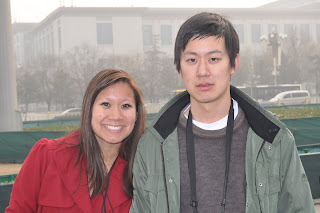Xian religious site #1- Giant Wild Goose Pagoda
This pagoda, now part of a Buddhist monastery, had historically served as a repository for many ancient texts. During the Cultural Revolution, however, most of these texts had been destroyed. The seven-storied structure was also a popular site for parents to bring their children, as it was said that taking a child to the top of the pagoda would ensure them good scores on their exams. Perhaps because of this, the pagoda leans slightly to the left, so unfortunately we didn't get to make the ascent to the top and instead spent the morning meandering around the courtyards and rooms surrounding the pagoda.
Imitating the Chinese tourists
group photo

The structures surrounding the pagoda were being rebuilt according to
their original plans, but in a sign of the times, these traditional
buildings were occupied by Pizza Hut, Subway, and their ilk.
For lunch we stopped at a restaurant called "Ding Ding Xiang," which roughly translates to "best aroma." It was the best Mexican food we had in China. Even though Ding Ding Xiang purported to be a Chinese crepe restaurant, with flour and spinach crepes to wrap around grilled beef and chicken, the wraps there tasted as good as any fajita I've ever had!
Xian religious site #2- Great Mosque
Xian is also home to a sizable contingent of Hui Muslims, who largely reside in the Muslim Quarter, a district of the city bustling with food vendors, souvenir salesmen, and a variety of shops.
The Great Mosque of Xian merges a Chinese architectural style with the Muslim faith, and looked less like a mosque and more like a traditional Chinese settlement than anything. A few men were praying in the main room of the mosque, which was a haven of tranquility amidst the bustle of the surrounding city.

Xian is also home to a sizable contingent of Hui Muslims, who largely reside in the Muslim Quarter, a district of the city bustling with food vendors, souvenir salesmen, and a variety of shops.
The Great Mosque of Xian merges a Chinese architectural style with the Muslim faith, and looked less like a mosque and more like a traditional Chinese settlement than anything. A few men were praying in the main room of the mosque, which was a haven of tranquility amidst the bustle of the surrounding city.

Once we exited the mosque to the Muslim Quarter, it was time for Goal #4- find Jia San, a Xian landmark ostensibly serving the best xiao long baos in the city. Sadly, it was not to be. While my sister and mom went to bargain with the hello people, my dad and I ventured out to Jia San and ended up taking the long way and and going completely around it.
According to Google Maps, after hotels the most common thing in this part of Xian is KFC



















































